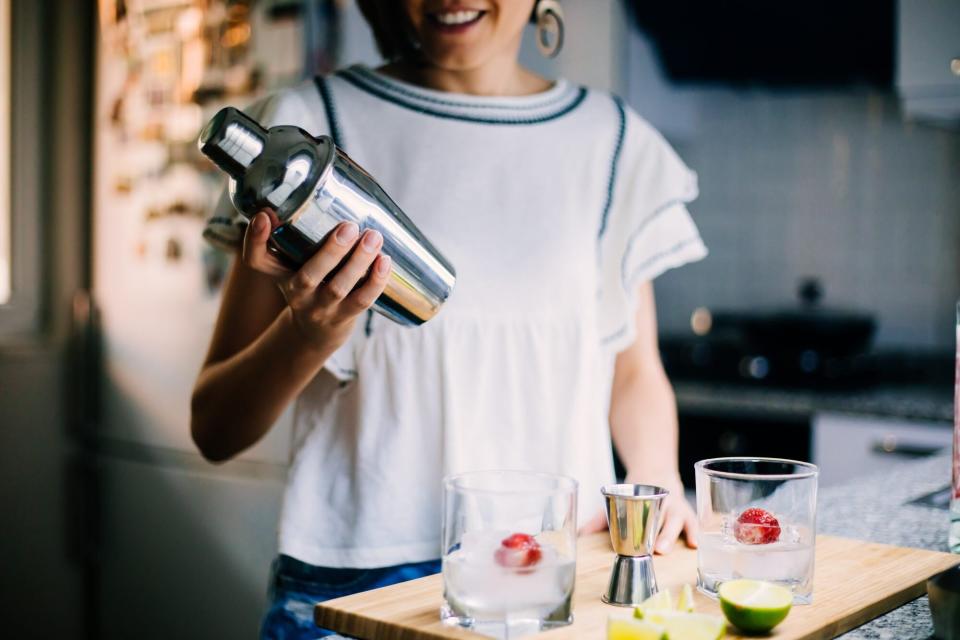What's the Right Way to Shake a Cocktail?
We've all seen bartenders shaking a tin vigorously before theatrically pouring out a perfectly chilled and blended cocktail—the pros make the art of shaking a cocktail look simple. But if you've ever been on the receiving end of a too-warm, completely undiluted drink, or else seen a glass break, tin get stuck, or liquid go flying, then you know it's not always that easy.
Thankfully, with proper guidance and a little bit of practice, shaking a cocktail correctly doesn't have to be complicated, and that's true regardless of which type of cocktail shaker you're using. We spoke to Brenda Riepenoff, the head bartender at Thief in Brooklyn, New York, to learn the best way to shake a cocktail. Read on for her tips and tricks.
Related: Which Style of Cocktail Shaker Is Best for You?

agrobacter / Getty Images
Start with the Least Expensive Ingredients
Ask any bartender how to build a cocktail, and they'll tell you to add the booze last. Why? Because it's usually the most expensive ingredient. "The overarching idea is that you could always mess it up," explains Reipenoff. "So you want to start with your least expensive ingredients, which usually means citrus juice and syrups and then any liqueurs, and then your main spirit." This way, if you add the wrong amount or spill, hopefully you won't have wasted the alcohol yet. The takeaway? Add your ingredients one at a time to the shaker with ice, always adding the booze last.
Use Two Hands
Unless you're a professional bartending a high-volume party or establishment, you'll probably want to stick to shaking one cocktail at a time, which means using both hands to hold the shaker together. Riepenoff uses a Boston shaker, which has two parts; "I like to have one hand on the top of the small shaker and one on the bottom of the big shaker, which helps hold it together," says Reipenoff. "Even though the cocktail shaker automatically vacuum seals to an extent, this gives some extra security." Another important tip? Hold the shaker so the small tin is facing the person shaking it. This way, if it does open, it will spill on you and not your guests.
Don't Shake Too Hard or Too Gently
When you shake a cocktail with ice, the goal is to blend the ingredients, but also to chill them and dilute the alcohol slightly. "You don't want to shake super hard like a maniac because then all the ice will chip and the cocktail gets over diluted," says Reipenoff. "But you don't want to shake it too lightly, either, where the drink isn't diluted at all and it's not cold enough. You just have to find that happy medium." She adds that everyone has their own shaking style, and as long as you're in a middle ground of shaking strength, anything goes in terms of the specific motion.
Shake for 15 to 20 Seconds
Reipenoff shares that professional bartenders develop a gut feeling that lets them know when a cocktail is properly blended, so practice will make perfect. The size of your ice will also impact ho long your cocktail needs to be shaken (bigger ice dilutes more slowly). The general rule of thumb? You should shake each cocktail vigorously for 15 to 20 seconds. "You might start to feel the ice breaking up, and you can feel the temperature when the tin starts to get frosty, so use your instincts," she says.
If You're Using Egg Whites, Do a Double Shake
If you're making a drink that has egg whites or a whole egg as an ingredient—like a classic whiskey sour or a flip—then you'll need to do two shakes. The first is to thoroughly emulsify all the ingredients (including the egg) and the second is to cool and dilute it as usual. "First, shake the ingredients without ice to make sure everything is really well integrated and the texture is right," says Reipenoff. "Then, add the ice, which helps get everything even more integrated but also dilute and chill it." She also adds that you should do that first shake a bit more forcefully than usual, in order to fully emulsify—plus, you don't have to worry about the ice chipping or over-diluting since there's no ice in it yet.

